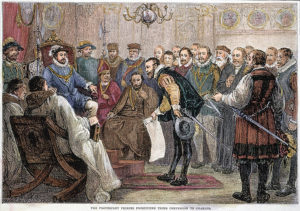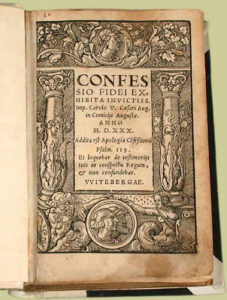Commemoration of the Presentation of the Augsburg Confession
June 25
June 25 is the day set aside to commemorate the presentation of the Augsburg Confession. This is the document that was formally presented to the Holy Roman Emperor, Charles V, at the Diet of Augsburg, on June 25, 1530 (hence the name of the confession and the date selected to commemorate it). Augsburg was a city in Germany. “Diet” is an old word for a conference. The Augsburg Confession contained the views of the Evangelicals (Lutherans) and is their statement of faith.
On October 31, 1517, Martin Luther nailed his now famous 95 Theses to the castle church door in Wittenberg, Germany. This was intended as a call for an academic debate. That debate never happened, but the announcement sparked debate around the Holy Roman Empire from the halls of power to the fields of the peasants. Thus began the Protestant/Lutheran Reformation.
Many were coming to believe that the Roman Church had accepted false and abusive practices. To be honest, many Roman Catholic scholars today agree that the century leading up to the Reformation was, in many ways, a low point for their church. Others think it was a high point, but these are people who value the church for what it accomplished in the way of art, architecture, and the like, not for its role as a caregiver to souls or a promoter of clear moral standards. The Roman Church, in many ways, had sunk into the games of power politics.
As the Reformation picked up momentum, the political powers of the Holy Roman Empire (Charles V), and the leaders in Rome, became alarmed. However, just marshaling an army and attacking the places where the Reformation was flourishing, wasn’t practical. At the eastern boarder of the Empire was a serious threat to Europe, the Ottoman Empire. This Moslem Empire was constantly seeking any weakness in the Holy Roman Empire in its Jihad (“holy” war) against the West.
 The Diet of Augsburg was called as a way to bring the Church back together under the leadership of the Pope. The idea was presented to the Evangelicals as a way to present and defend their positions, hopefully (from their point of view) demonstrating that they were faithful sons of the Roman Church, but from the Roman point of view as a way to discredit the Evangelicals, bringing them to recant their views, and return to the leadership of the Pope.
The Diet of Augsburg was called as a way to bring the Church back together under the leadership of the Pope. The idea was presented to the Evangelicals as a way to present and defend their positions, hopefully (from their point of view) demonstrating that they were faithful sons of the Roman Church, but from the Roman point of view as a way to discredit the Evangelicals, bringing them to recant their views, and return to the leadership of the Pope.
The Evangelicals learned that the cards were stacked against them. They were going to be accused of believing all kinds of harebrained ideas (like rejecting the Trinity, rejecting the Two Natures of Jesus, etc.). The Evangelicals had originally planned to focus only on areas that were in dispute, but when they found out that they would be accused of things they did not teach, a more comprehensive presentation needed to be drawn up.
The decision was made to accent, not just what the Evangelicals believed that was different from Rome, but also what they believed that they held in common with Rome. Martin Luther would have been the natural choice to write and present the position of the Evangelicals, but he was under the Imperial Ban. That means he was an outlaw and could be killed on sight. So the job fell to Philip Melanchthon, pretty much Luther’s right-hand man.
 The irenic tone of the document, and the clear statements about such things like the Trinity and who Jesus is, caught the Roman delegation completely off guard. Those who attended the Diet said that, when the Augsburg Confession was read, the audience was so quiet you could hear a pin drop. The Roman representatives couldn’t simply condemn the Protestants because they would, at times, be condemning their own positions.
The irenic tone of the document, and the clear statements about such things like the Trinity and who Jesus is, caught the Roman delegation completely off guard. Those who attended the Diet said that, when the Augsburg Confession was read, the audience was so quiet you could hear a pin drop. The Roman representatives couldn’t simply condemn the Protestants because they would, at times, be condemning their own positions.
A response was prepared quickly, and in a couple of weeks read. As it was read, eye-witnesses said the people in the audience actually burst out into laughter as it was so poorly reasoned. Nonetheless, the Emperor declared that the Protestants were refuted and demanded that they recant. The Protestant princes refused. Due to the threat of the Ottoman Empire, Charles’s hands were tied. The Evangelical cause continued, now with a clear statement of what it meant to be an Evangelical.
The document is divided into three main sections. One dealt with what Evangelicals believed, taught, and confessed. Another dealt with abuses in the Roman Church. The third dealt with areas in which the Evangelicals thought discussion could profitably be engaged. Soon Protestants all around the Empire were “subscribing” to the Augsburg Confession, making it the first generally accepted expression of Protestant/Evangelical Faith.
Prayer: Lord God, heavenly Father, You preserved the teaching of the apostolic Church through the confession of the true faith at Augsburg. Continue to cast the bright beams of Your light upon Your Church that we, being instructed by the doctrine of the blessed apostles, may walk in the light of everlasting life; through Jesus Christ, our Lord, who lives and reigns with You and the Holy Spirit, one God, now and forever. Amen.
Other appropriate prayers
• For the unity of the church
• For the preaching and teaching of pure doctrine
• For a deeper knowledge of Christ and his benefits
• For the power of the gospel to fill the church
Blessings in Christ,
Pastor John Rickert
